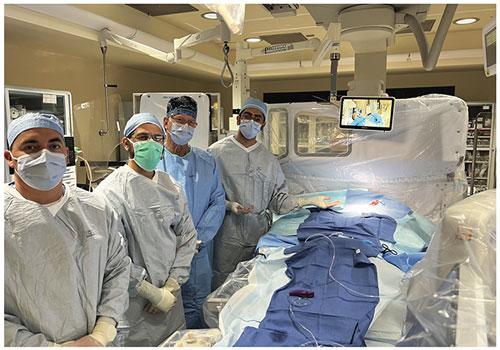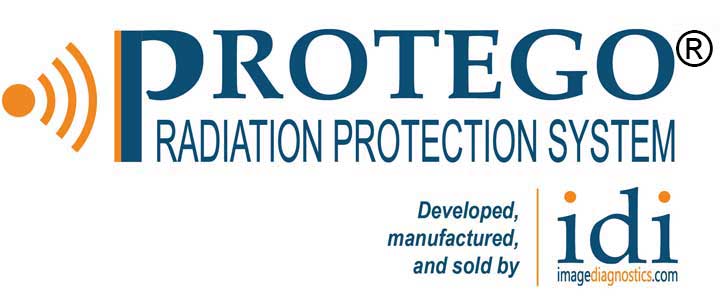In the Media
“SCAI’s advocacy centers on enhanced radiation protection devices (EPDs), an emerging category of technology that dramatically reduces exposure without the need for traditional, wearable lead shielding. These innovations promise not only to protect physicians, but also the entire cath lab team, including nurses, technologists and sonographers” | Cardiovascular Business | Interventional Cardiology
Shield system cuts operator exposure to radiation during cath lab procedures
“The use of a radiation shield system—Protego (Image Diagnostics)—could markedly cut the exposure of cath lab staff to radiation during coronary and structural heart procedures, new research suggests.” Cardiovascular News 22 March 2024
“With the use of the system, known as Protego (Image Diagnostics), a busy interventionalist could perform about 400 cases and be exposed to less than 1% of the Occupational Safety and Health Administration’s maximum annual allowable radiation exposure threshold.”, said David Rizik, MD (HonorHealth, Scottsdale, AZ), in his presentation.
TCTMD https://www.tctmd.com/news/comprehensive-radiation-shield-sharply-cuts-operator-exposure
PROTEGO Studies

Long Beach VA Medical Center Cath lab team without lead aprons using the Protego system (Image Diagnostics)
Article: Optimal Angiography Post PCI: Should the Guidewire Stay In or Out? Do Small Changes in Cath Lab Techniques Matter?(CathLabDigest)
Morton J. Kern, MD, MSCAI, FACC, FAHA
Clinical Editor; Interventional Cardiologist, Long Beach VA Medical Center, Long Beach, California; Professor of Medicine, University of California, Irvine Medical Center, Orange, California, January 2024
https://www.hmpgloballearningnetwork.com/site/cathlab/clinical-editors-corner/optimal-angiography-post-pci-should-guidewire-stay-or-out-do
Article: Comprehensive radiation shield minimizes operator radiation exposure in coronary and structural heart procedures
David G. Rizik a,⁎, Kevin P. Gosselin b, Robert F. Burke a, James A. Goldstein, Cardiovascular Revascularization Medicine
Article: Occupationally Exposed: It Is Time to Protect Ourselves!
Paul N. Filrilli, MD, Andrew M Soldsweig, MD, MS,JSCAI
Article: SCAI Multi-Society Position Statement on Occupational Health Hazards of the Catheterization Laboratory: Shifting the Paradigm for Healthcare Workers’ Protection
Lloyd W. Klein, MD, FACC, MSCAI*, James A. Goldstein, MD, FACC, FSCAIy, David Haines, MD, FACC, FHRSy, Charles Chambers, MD, FACC, MSCAIz, Roxana Mehran, MD, FACC, MSCAI, Smadar Kort, MD, FACC, FASE, C. Michael Valentine, MD, MACC, FSCAIk, David Cox, MD, MSCAI, FACC, Journal of the American College of Cardiology
Article: Zero Radiation in the Cardiac Catheterization Laboratory: An Aspirational Goal or Moral Imperative?
David G. Rizik, MDa,*, Michael B. Rizik, JD, MSFb
Article: Radiation Doses to the Entire Catheterization Laboratory Team With a Novel Radiation Protection Device (jscai.org)
Malav J. Parikh MD, Lahdan Refahiyat MD, Timothy A. Joseph MD, David McNamara MD, Ryan D. Madder MD, Journal of the Society for Cardiovascular Angiography & Interventions, 19 October 2023, 101109 https://www.jscai.org/article/S2772-9303(23)00815-3/fulltext
Article: Comprehensive Radiation Shield Minimizes Operator Radiation Exposure and Obviates Need for Lead Aprons – Journal of the Society for Cardiovascular Angiography & Interventions (jscai.org)
Rizik, David G. MD , Robert D. Riley, MD, Robert F. Burke, MD, Sabrina R. Klassen, Ariana M. Nigoghosian, Kevin P. Gosselin, PhD, and James A. Goldstein, MD, “Comprehensive Radiation Shield Minimizes Operator Radiation Exposure and Obviates Need for Lead Aprons,” JSCAI, March 21, 2023. https://www.jscai.org/article/S2772-9303(23)00030-3/fulltext
Editorial: Occupationally Exposed: It Is Time to Protect Ourselves! (jscai.org)
Fiorilli, Paul N. MD and Andrew M. Goldsweig, MD, MS “Occupationally Exposed: It Is Time to Protect Ourselves!” ,” JSCAI, March 21, 2023. https://www.jscai.org/article/S2772-9303(23)00037-6/fulltext
Article: A novel comprehensive radiation shielding system eliminates the need for personal lead aprons in the catheterization laboratory
Authors: Maher Rabah, Sorcha Allen, Amr E Abbas, Simon Dixon
PMID: 36453459 DOI: 10.1002/ccd.30490 https://pubmed.ncbi.nlm.nih.gov/36453459/
Article: SCAI Multi-Society Position Statement on Occupational Health Hazards of the Catheterization Laboratory: Shifting the Paradigm for Healthcare Workers’ Protection
Authors: Lloyd W Klein, James A Goldstein, David Haines, Charles Chambers, Roxana Mehran, Smadar Kort, C Michael Valentine, David Cox
PMID: 32273037 DOI: 10.1016/j.jacc.2020.02.015 https://pubmed.ncbi.nlm.nih.gov/32273037/
Article: Occupational Health Hazards of lnterventional Cardiologists in the Current Decade: Results of the 2014 SCAI Membership Survey
Authors: Lloyd W. Klein, MD, Yolande Tra, PhD, Kirk N. Garratt MD, Wayne Powell, MPS, Georgina Lopez-Cruz, MHSA, Charles Chambers, MD, FSCAI and James A. Goldstein,* MD, FSCAIAI, On Behalf of the Society for Cardiovascular Angiography and Interventions https://pubmed.ncbi.nlm.nih.gov/25810341/
Article: Radiation Exposure Among Scrub Technologists and Nurse Circulators During Cardiac Catheterization: The Impact of Accessory Lead Shields
Authors: Ryan D. Madder MD, Andrew LaCombe MD, Stacie VanOosterhout Med, Abbey Mulder BSN, RN, Matthew Elmore MA, Jessica L. Parker MS, Mark E. Jacoby MD, David Wohns MD
Citation: JACC: CARDIOVASCULAR INTERVENTIONS VOL.11, NO.2, 2018 BY THE AMERICAN COLLEGE OF CARDIOLOGY FOUNDATION
https://www.sciencedirect.com/science/article/pii/S1936879817315455?via%3Dihub
Abstract: Assessment of occupational dose reduction with the use of a floor-mounted mobile lead radiation protection shield
Authors: Hannah Scott, Sean Gallagher, William Abbott, and Matthew Talboy
Citation: , ,
https://doi.org/10.1016/j.carrev.2021.05.017
Policy Reference: MIOSHA RSS-0037, Card Cath Protection System
Policy Name: “Cardiac Catheterization Operator Protection System in Lieu of Lead Aprons”
Author: Michigan Occupation Safety and Health Administration, Technical Services Division, Policies And Procedures, Radiation Safety Section
Date: February 7, 2021
Article: A novel catheterization laboratory radiation shielding system: Results of pre-clinical testing
Authors: Dixon, Simon R., Maher Rabah, Scott Emerson, Cheryl Schultz, Ryan D. Madder
Link: https://doi.org/10.1016/j.carrev.2021.05.017
Citation: Dixon, Simon R., et al, “A novel catheterization laboratory radiation shielding system: Results of pre-clinical testing,” Cardiovascular Revascularization Medicine, https://www.sciencedirect.com/science/article/abs/pii/S1553838921002633 May 21, 2021.
Article: Economic Impacts of Radiation Exposures Associated with Interventional Fluoroscopy
Authors: Organization for Occupational Radiation Safety in Interventional Fluoroscopy (ORSIF)
https://orsif.org
Citation: ORSIF, “Economic Impacts of Radiation Exposures Associated with Interventional Fluoroscopy,” https://orsif.org, December 2018.
Website: Organization for Occupational Radiation Safety in Interventional Fluoroscopy
https://orsif.org
Article: Tumors, Bad Backs, and Cataracts: Interventional Physicians Face a Lifetime of Risk
Authors: Michael O’Riordan
https://www.tctmd.com/news/tumors-bad-backs-and-cataracts-interventional-physicians-face-lifetime-risk
Citation: O’Riordan, Michael, “Tumors, Bad Backs, and Cataracts: Interventional Physicians Face a Lifetime of Risk,” Presentations at: International Symposium on Endovascular Therapy; February 6-10, 2016; Hollywood, FL.
Ramparts IC Articles
Article: Use of a Rampart Radiation Protection System to reduce staff dose in Cath Lab
Authors: C. Banahan, D. Keogh, E. Loughman, S. Maguire Master Private Network, Dublin, Ireland
https://az659834.vo.msecnd.net/eventsairwesteuprod/production-abbey-public/339cc8005d00417dbdf438811b90d5ce
Conclusion: “Incorrect positioning of the Rampart device lead to gaps which resulted in high instantaneous dose rate measurements. Dedicated trained Cath Lab staff would be required to ensure correct set-up between cases and for adjustments mid-procedure as required.
For this reason, we would not advise staff to use this device without lead aprons to ensure consistency in radiation protection measures during cases.”
